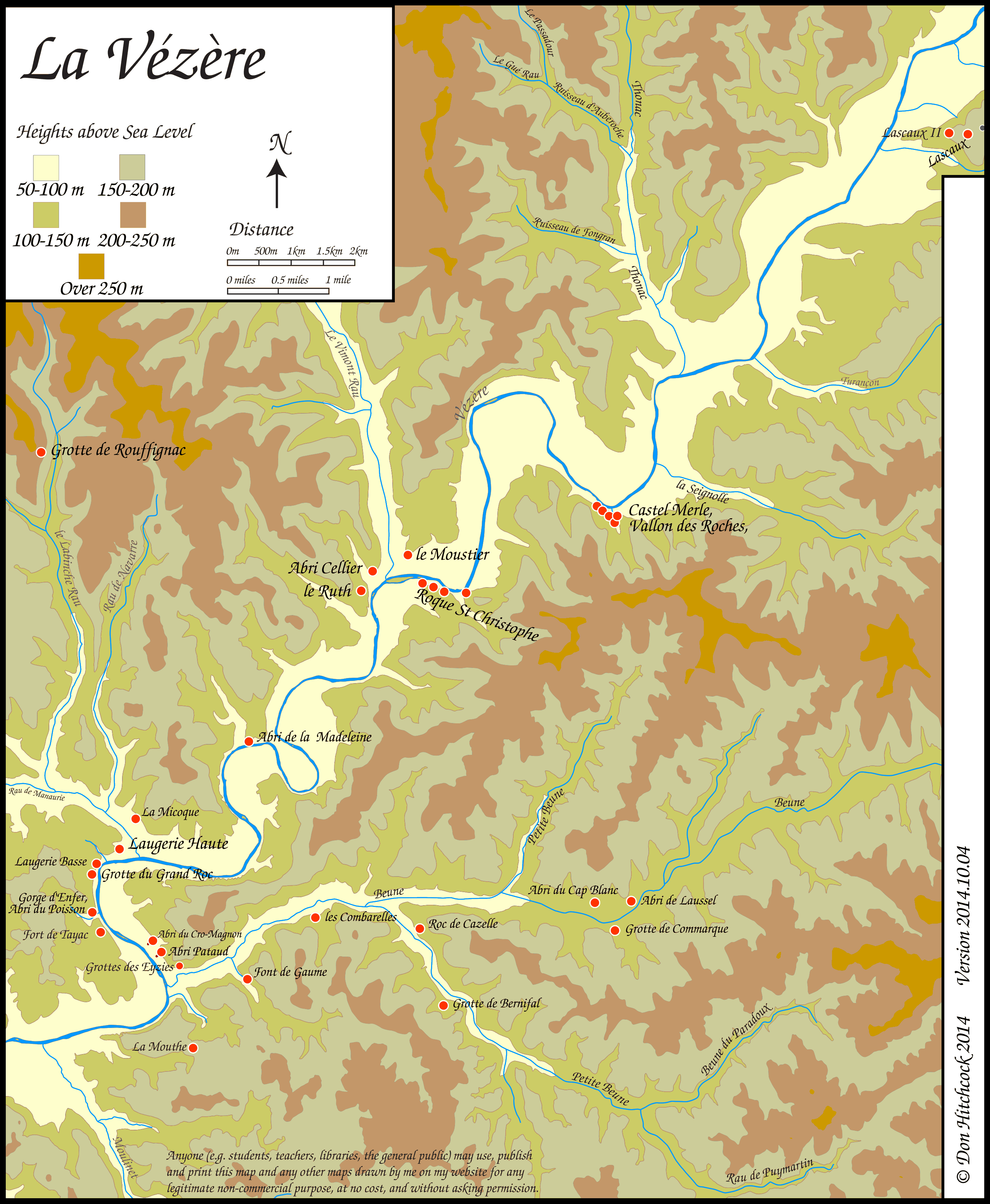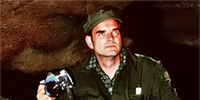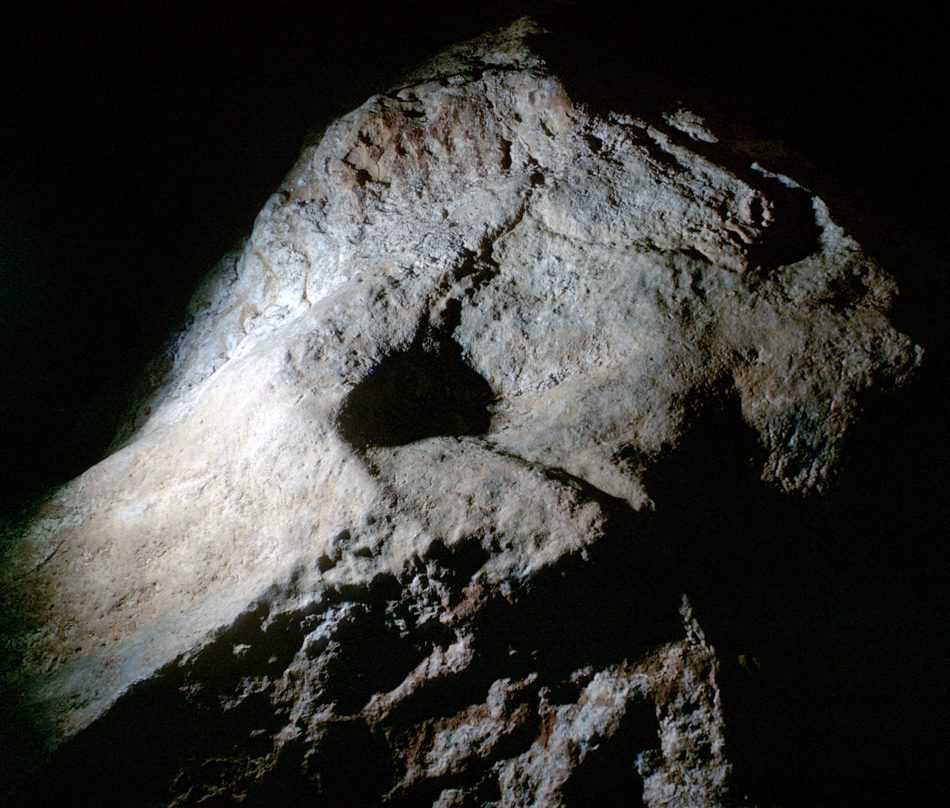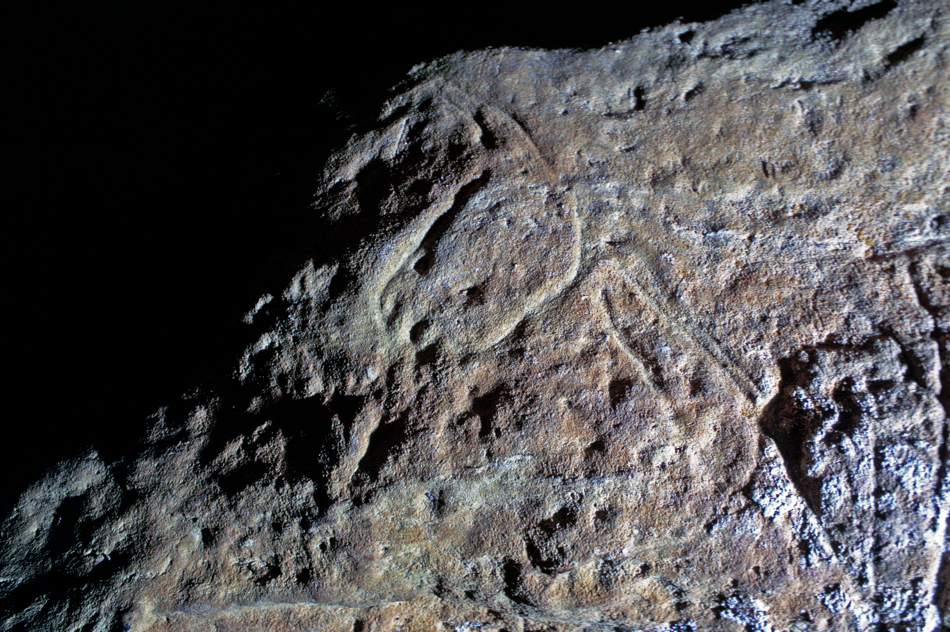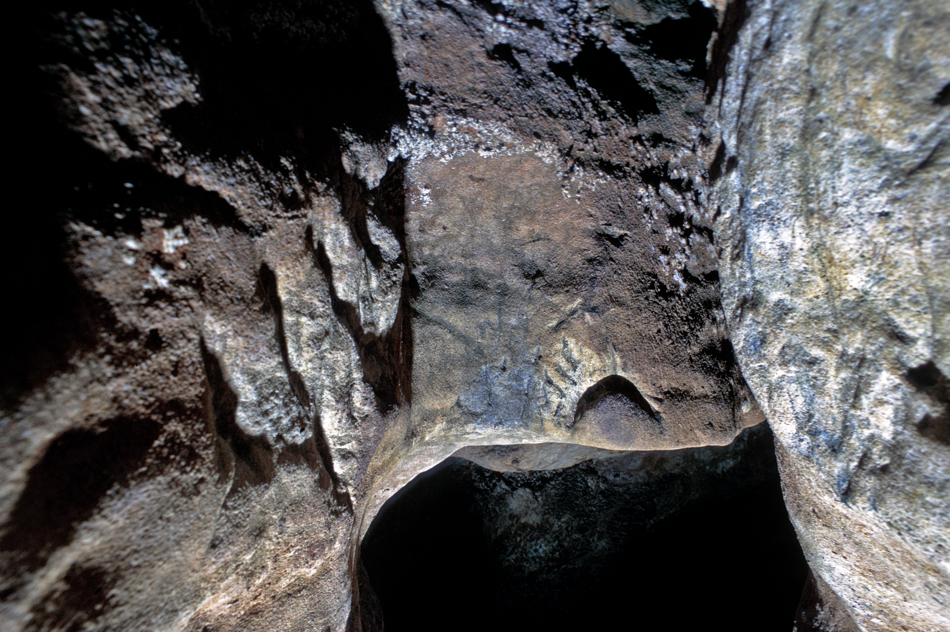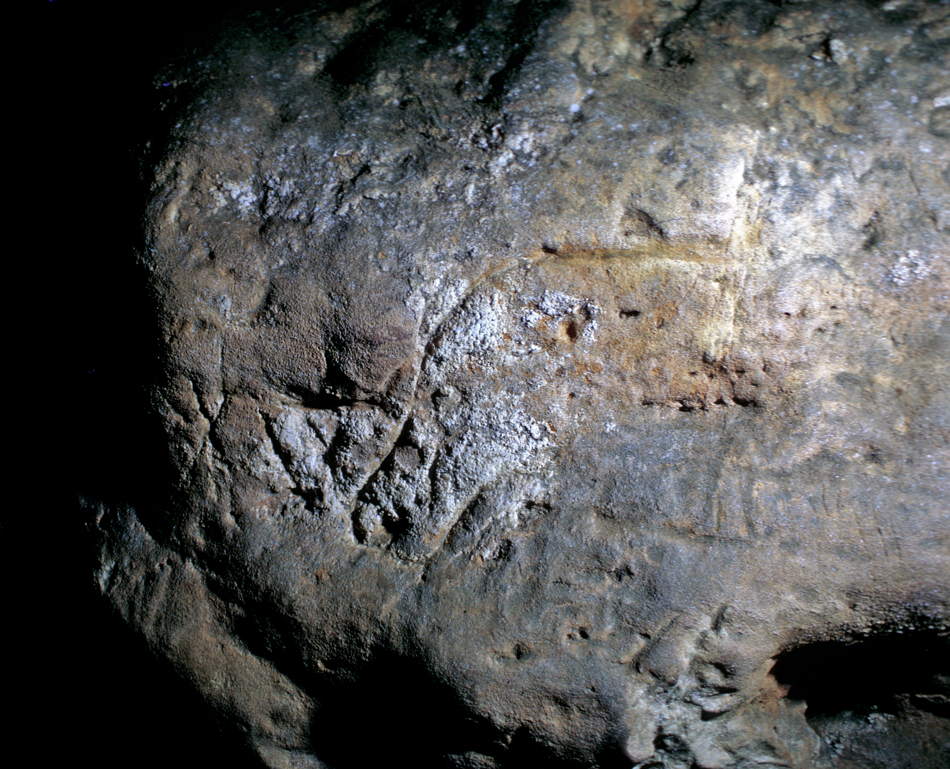Back to Don's Maps
 Back to Archaeological Sites
Back to Archaeological Sites
Grotte de Commarque
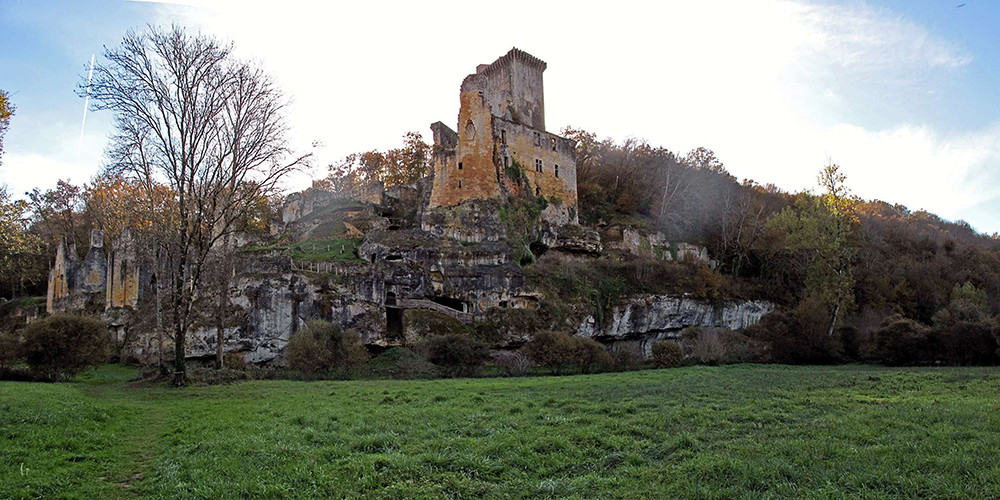
Chateau de Commarque. Various caves and shelters used by prehistoric people may be seen in the limestone under the Chateau in this photograph.
Photo: Happytrails, Panoramio
Text below from Brigitte and Gilles Delluc, in Leroi-Gourhan (1984):
The cave of Commarque at Sireuil is at the foot of a cliff supporting the ruins of the castle of Commarque. The flanks of this rock are excavated with mediaeval dwellings. The ruin and cliffs dominate the confluence of the small river of Commarque with the Beune du Nord or Grande Beune.
On the other bank are the shelters of Laussel, opposite, then, a few hundred metres downstream, the shelter of Cap Blanc and the small cave of La Grèze. The cave, private property, is classified as a historic monument since February 12, 1924.
This small horizontal cave of about 60 metres in extent consists essentially of an entry chamber and two decorated galleries, interrupted by side passages, in the Coniac limestone.
The ornate character of the cave was discovered by Abbé Henri Breuil, accompanied by P. Paris and his sons, in August 1915. He wrote a short monograph shortly after (Capitan, Breuil, Peyrony, 1915)
On the initiative of the A. Leroi-Gourhan, a study was recently conducted by the authors of this note, Brigitte and Gilles Delluc, which resulted in the discovery, in 1977, of new figures (six incomplete animals, a human head in profile, five realistic vulvas, three female figures or at least gynoids), a fairly successful survey in the entrance hall and the writing of a monograph (Delluc et al. 1981).
During this study (in 1979), a sondage in the entrance hall confirmed that most of the original soil was no longer in place, but a part of the Magdalenian layer was discovered, preserved in a small pocket beside the wall. The remains discovered were mainly of bone fragments with some flint tools (homogeneous material, attributable to the Magdalenian). Three samples of sediment provided A. Leroi-Gourhan with pollen corresponding, without any mixing, to a very cold and dry climate. The bone remains of this pocket consisted of reindeer, three quarters of which bore traces of cutting and defleshing. The birdlife and the microfauna also corresponded to a cold period.
Two 14C radiocarbon dates on the bone remains gave concordant results, the second of these measurements having been made on reindeer bone samples exclusively. The results are as follows: 13370 BP ± 340, 12760 BP ± 200 with a mean of 12880 BP ± 170. The occupation of the cave by the reindeer hunters therefore took place at the end of Dryas 1.
Map of sites in the Vézère Valley of France, including l'Abri du Cap Blanc, near which is the Grotte de Commarque
If you click on the map you will see a larger map with the ability to click on the marked sites and get further information.
Photo: Don Hitchcock
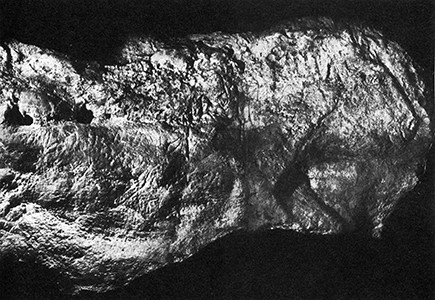
Group of engravings at the end of the decorated gallery. The giant horse is on the right.
Photo: Photo-montage of twenty photos by B. and G. Delluc
Source: Leroi-Gourhan (1984)
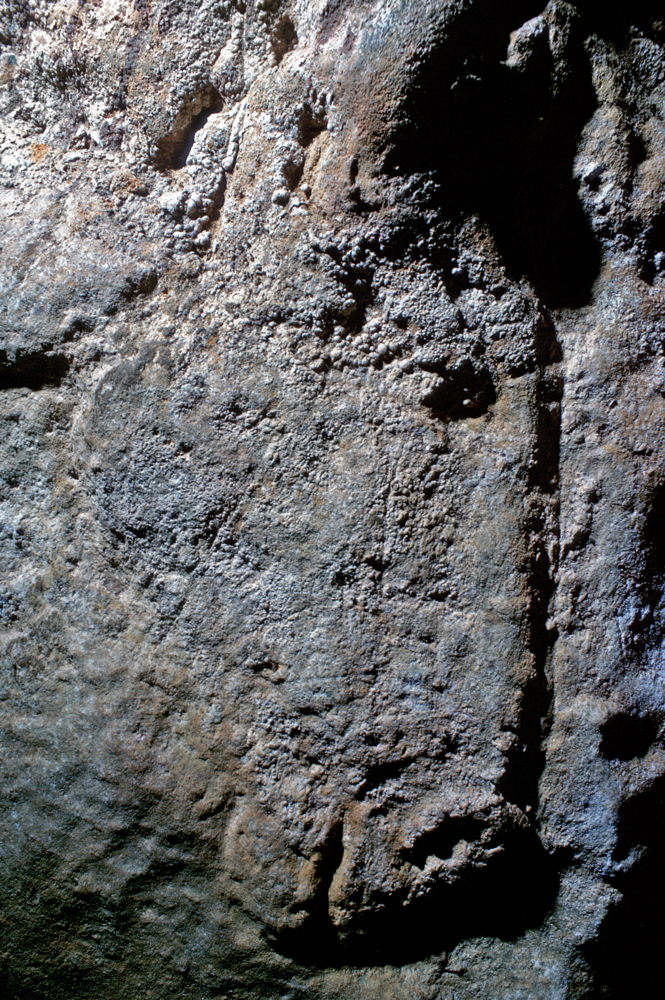
The giant horse of Commarque.
Photo: Heinrich Wendel (© The Wendel Collection, Neanderthal Museum)
The giant horse of Commarque, distant shot, labelled as 'equid' in the Wendel Collection site.
Photo: Heinrich Wendel (© The Wendel Collection, Neanderthal Museum)
Labelled as 'Cave wall' in the Wendel Collection site, this appears to show a bas-relief of a horse, with head, body, and one front leg.
Photo: Heinrich Wendel (© The Wendel Collection, Neanderthal Museum)
Although this is only identified as 'lines' in the source data set, I feel sure I can make out what appears to be a horse's head in the centre of the image.
Photo: Heinrich Wendel (© The Wendel Collection, Neanderthal Museum)
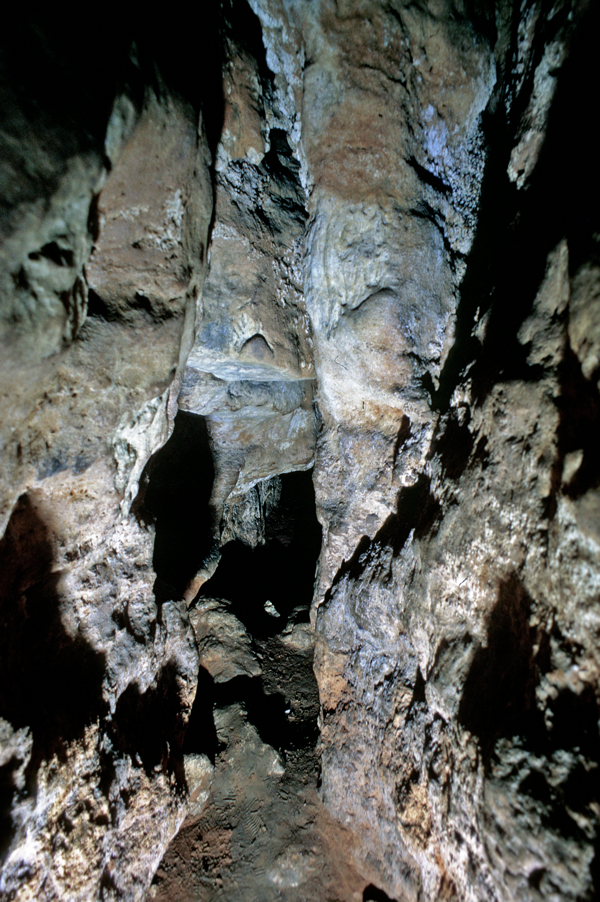
Cave interior.
Photo: Heinrich Wendel (© The Wendel Collection, Neanderthal Museum)
Cave interior.
Photo: Heinrich Wendel (© The Wendel Collection, Neanderthal Museum)
Cave interior. Labelled on the data set as 'lines', this appears to portray the head of a bear, as well as 'X' markings.
Photo: Heinrich Wendel (© The Wendel Collection, Neanderthal Museum)
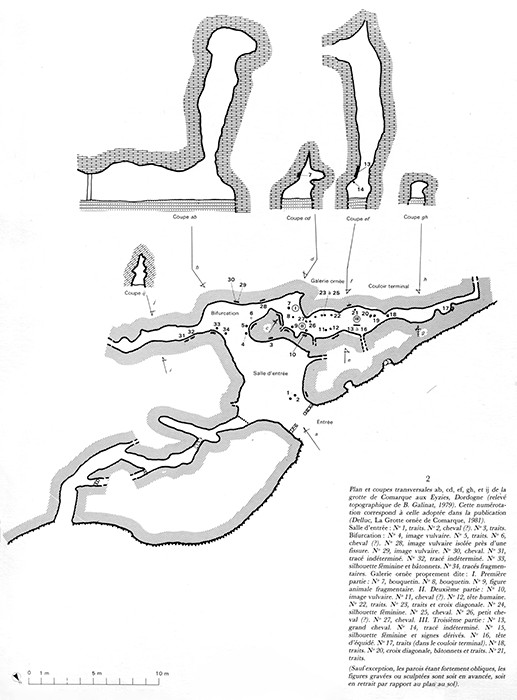
Plan and transversal cross sections of the Grotte de Commarque.
Photo: B. Galinat, 1979
Source: Leroi-Gourhan (1984)
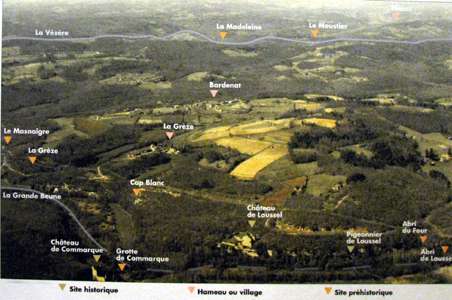
The area is rich in archeological treasures. Here is an aerial photograph of the area with the major sites.
Photo: Display at L'Abri du Cap Blanc.

Grotte de Commarque is under the ruins of the Chateau de Commarque, not at the exact latitude and longitude shown on this photo, 44.941000N, 1.101000E which comes from http://www.megalithic.co.uk/
The ruins of the castle may be seen just above the marked latitude and longitude.
Photo: Google Earth

Engraving of a horse from the Grotte de Commarque.
Photo: Display, Cap Blanc

The principal figures from the bifurcation.
Above, three vulvas and a female silhouette.
Below, two horses.
Photo: B. and G. Delluc
Source: Leroi-Gourhan (1984)

On the left, a large isolated vulva near the entry to a side passage.
On the right, the two ibex from the first group of the decorated gallery.
Photo: B. and G. Delluc
Source: Leroi-Gourhan (1984)

The second group of the decorated gallery.
Above, the figures from the left wall (south-west).
Below, the figures from the right wall (north-east).
Photo: B. and G. Delluc
Source: Leroi-Gourhan (1984)
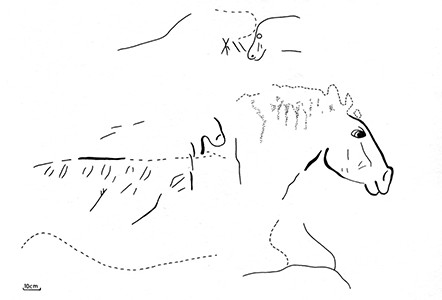
The group from the end of the decorated gallery.
Above, the figures from the left wall (south-east).
Below, the figures from the right wall (north-west).
Photo: B. and G. Delluc
Source: Leroi-Gourhan (1984)
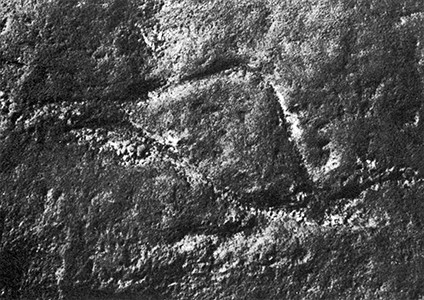
First group of the decorated gallery.
On the left of this group is this feminine silhouette, in the Lalinde/Gönnersdorf style.
Photo: B. and G. Delluc
Source: Leroi-Gourhan (1984)
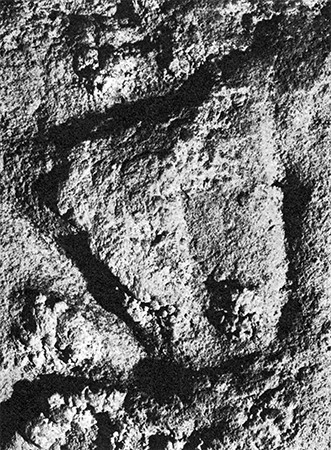
First group of the decorated gallery.
On the right of this group is this engraving of a vulva.
Photo: B. and G. Delluc
Source: Leroi-Gourhan (1984)

La Grotte de Commarque is located under the Chateau de Commarque, as seen here.
Photo: Jacques Wolkiewiez, http://www.archeociel.com/lascaux.htm
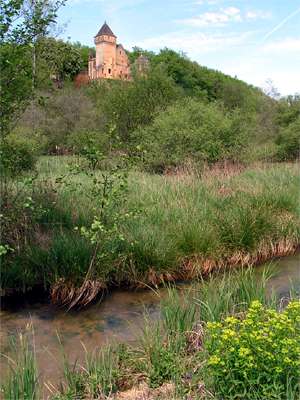
Rich meadow near Cap Blanc, between Chateau Laussel (pictured) and Chateau Commarque.
Photo: Hans Briaire, Panoramio
References
- Bourdier C., Abgrall A., Huard O., Le Brun E., Peyroux M., Pinçon G. , 2010: Histoires de Bisons et de Chevaux: Regard sur l'évolution de la frise pariétale de Cap-Blanc (Marquay, Dordogne) à travers l’analyse du panneau de l’alcôve, Paleo No 21 2009 - 2010 pp. 17 - 38
- Capitan L., Breuil H., Peyrony D., 1915: Nouvelles grottes ornées de la vallée de la Beune. 1 : La grotte de Comarque; Il : la grotte de Nancy à Viel-Mouly (Sireuil); III : Les grottes de Beyssac, L'Anthropologie t. 26, 1915, p. 505-518, 13 fig.
- Castel, J., Chadelle J., 1992: Cap Blanc (Marquay, Dordogne), L'apport de la fouille de 1992 à la connaissance des activités humaines et à l'attribution culturelle des sculptures / Cap Blanc (Marquay, Dordogne), Paléo. N. 12, 2000. pp. 61-75.
- Delluc B. et G., Chaline j., Evin J., Galinat B., Leroi-Gourhan A., Mourer-Chauviré C., Poulain T., Schweingruber F., 1981: La Grotte ornée de Comarque à Sireuil (Dordogne), Gallia Préhistoire, t. 24, fasc. 1, p. 1 - 97, 56 fig.
- Delpech F., 1983: Les faunes du Paléolithique supérieur dans le Sud-Ouest de la France. Cahiers du Quaternaire, 6, Editions du CNRS.
- Desdemaines-Hugon C. , 2010: Stepping Stones, Yale
- Lalanne G., 1910: Un atelier de sculpture de l'Age du Renne. La Revue Préhistorique, 5, 33-44.
- Lalanne G. et Breuil H., 1911: L'abri sculpté de Cap-Blanc (Marquay, Dordogne) L'Anthropologie, 22, p. 385-402.
- Leroi-Gourhan A., 1965: Préhistoire de l’art occidental, Paris : Mazenod, 485 p. ill..
- Leroi-Gourhan A., 1984: L'Art des cavernes : Atlas des grottes ornées paléolithiques françaises, Relié – 1 décembre 1984
- Pyrony D. , 1950: Notes sur quelques petits gisements préhistoriques. Bulletin de la Société Historique et Archéologique du Périgord, 77, p.55-64.
- Roussot A., 1972: Contribution à l’étude de la frise sculptée du Cap Blanc. In : M. Almagro Basch, M. A. Garcia Guinea (Ed.), Santander Symposium, Symposium internacional de arte rupestre. Santander (14-20 septembre 1970). Madrid : Consejo superior de investigaciones, pp. 87-115, 5 fig.
- Roussot A., 1984a: Abri de Laussel, L’Art des Cavernes. Atlas des grottes ornées paléolithiques françaises, Paris : Ministère de la Culture, pp. 167-169.
- Roussot A., 1984b: Abri du Cap-Blanc, L’Art des Cavernes. Atlas des grottes ornées paléolithiques françaises, Paris : Ministère de la Culture, pp. 157-163.
- Roussot A., 1994: Visiter le Cap-Blanc, Bordeaux : Sud-Ouest, 32 p.
